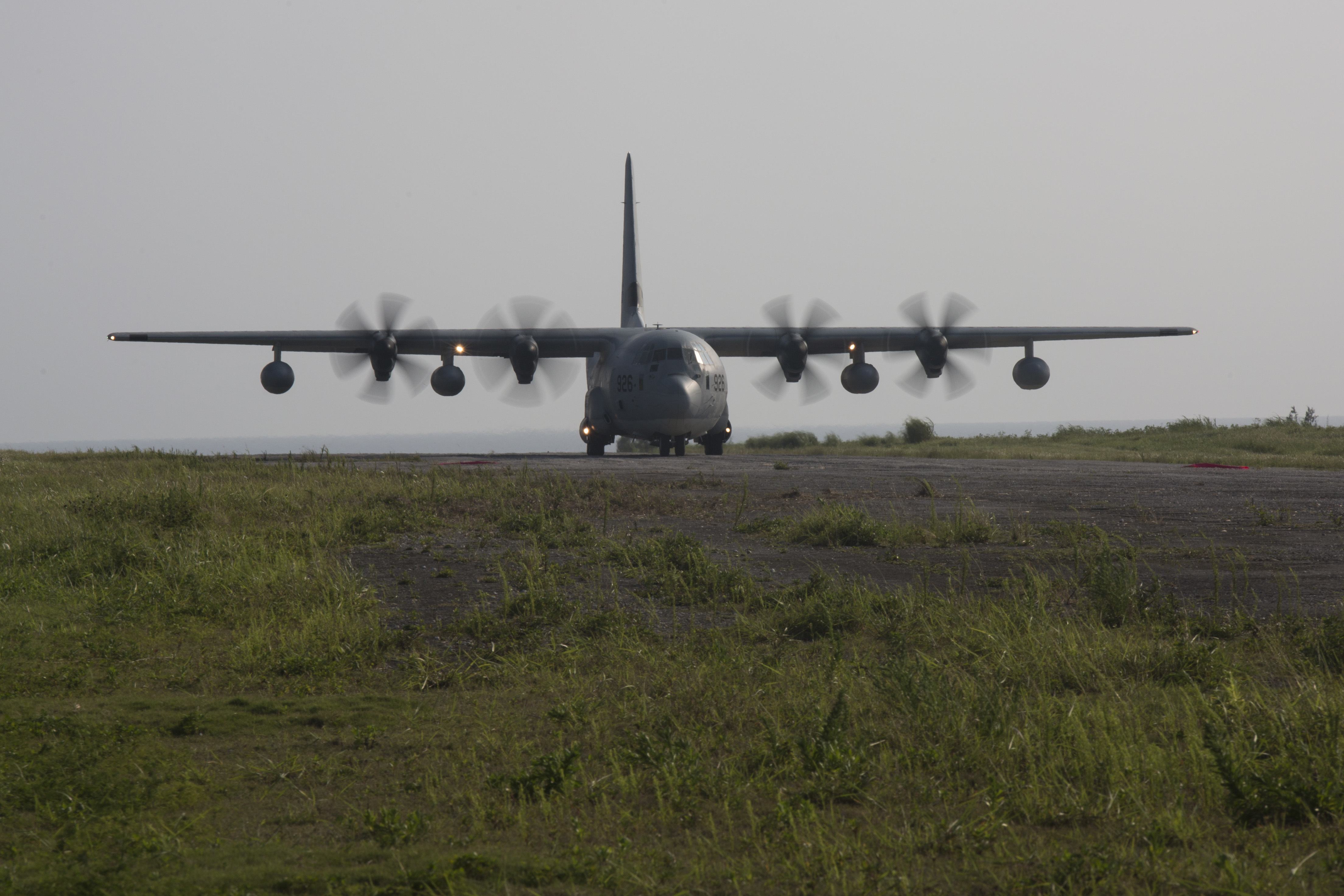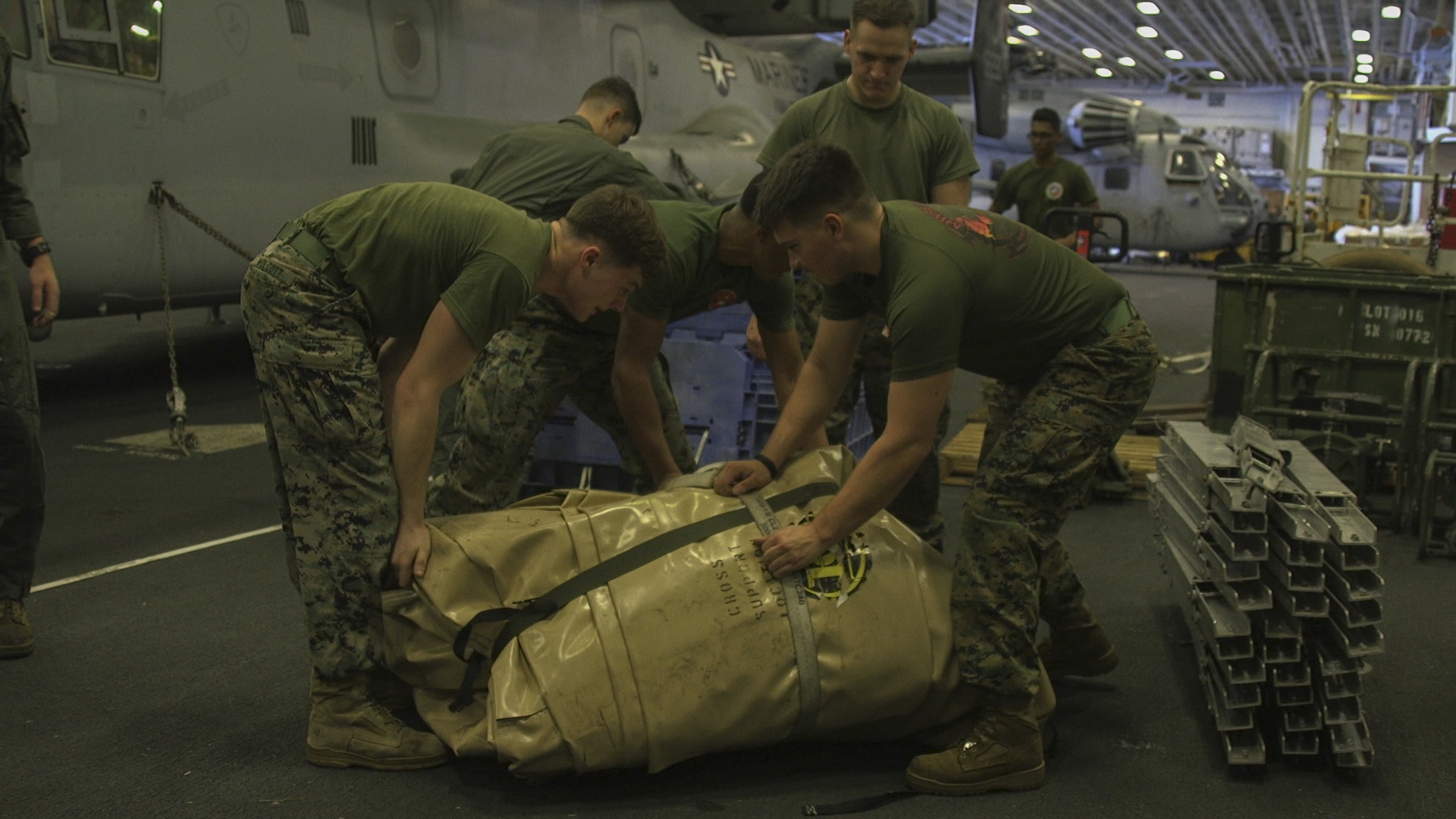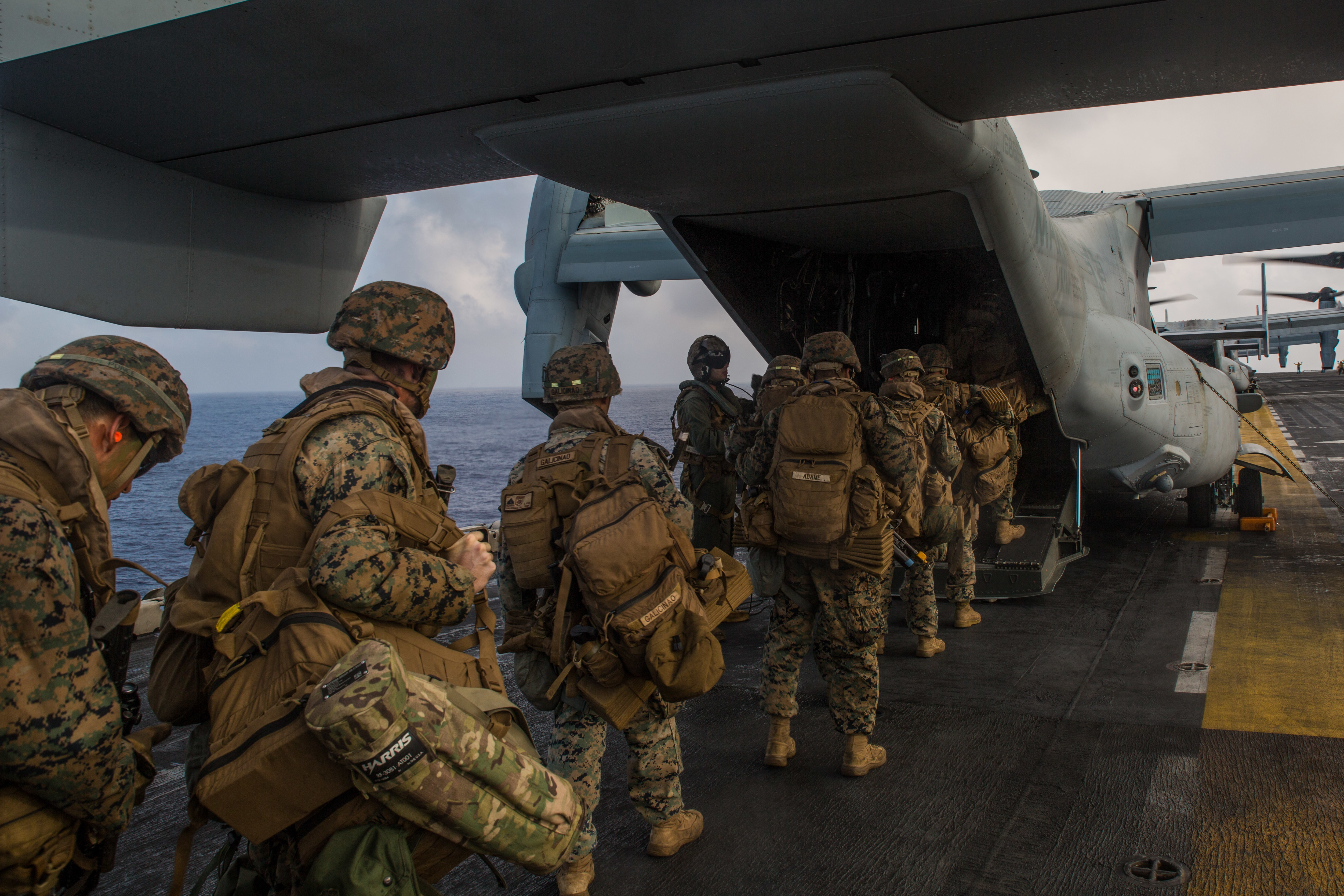
The U.S. Marine Corps has been refining a pair of related concepts, Expeditionary Advance Base Operations (EABO) and the overarching Littoral Operations in a Contested Environment, for the past couple years.
With the Navy now all-in on its related Distributed Maritime Operations concept – and with a new commandant of the Marine Corps focused on acquisition and training on supporting EABO and LOCE operations – U.S. Indo-Pacific Command is investing in exercises this year that test out the naval force’s ability to distribute its people across large swaths of land and sea – and its ability to bring the firepower, logistics and sustainment, and sea control needed to be successful despite the challenges of operating as small units far from the conveniences of a consolidated strike group at sea or land base ashore.
The 31st Marine Expeditionary Unit (MEU) and Wasp Amphibious Ready Group (ARG) last month demonstrated two long-range expeditionary capabilities that provide a glimpse into how future warfighting could be conducted in littoral areas such as the South China Sea or the Baltic Sea.
A pair of Marine Corps press releases published this week make these two maneuvers seem relatively straightforward, but they are in fact years in the making. Back in November 2016, Marines in the Pacific began practicing the most basic aspects of EABO: they conducted a series of raids ashore, moving from location to location without ever setting up a large footprint, and practicing camouflaging their aircraft in the field to reduce their chances of being detected before moving to the next location.

EABO-related efforts have grown in sophistication, from firing a (high-mobility artillery rocket system) HIMARS from an amphibious ship to support sea control to incorporating the new F-35B Joint Strike Fighter into island-hopping plans.
Last month’s pair of expeditionary demonstrations took previous efforts and expanded on them. Rather than setting up a forward arming and refueling point (FARP) for the F-35B, which can land and take off vertically in austere locations, the Marines set up a FARP for a KC-130 transport plane. And rather than use HIMARS to support one amphibious movement, they conducted multi-island seizures and power-projection efforts.
Here’s how the Marines did it:

Establishing a FARP to support KC-130 operations on a seized island
U.S. Marines with the 31st Marine Expeditionary Unit, operating from ships of the Wasp ARG, seized the Ie Shima Training Facility to establish a forward arming and refueling point (FARP).
Ingredients: 1 Amphibious Reconnaissance Platoon; 1 company of ground Marines; 1 amphibious assault ship; MV-22 tiltrotor aircraft; 1 CH-53E Super Stallion heavy-lift helicopter; 1 KC-130 transport plane
Time: 11 hours

-
- Reconnaissance Marines with the 31st MEU’s Amphibious Reconnaissance Platoon conducted a high altitude low opening (HALO) parachute jump onto the Ie Shima island to conduct reconnaissance and surveillance of the area.
- After the reconnaissance team finished surveilling the airfield, Marines with Echo Company, Battalion Landing Team, 2nd Battalion, 1st Marines vertically inserted via MV-22B Osprey tiltrotor aircraft from the USS Wasp (LHD-1) more than 250 miles away, rapidly seizing the objective in just over an hour.

- After perimeter security was set at the airfield, a CH-53E Super Stallion heavy-lift helicopter delivered three crates with the Helicopter Expeditionary Refueling System equipment to establish a FARP.
- Marines from I Marine Aircraft Wing, Marine Medium Tiltrotor Squadron 265 (Reinforced) and Echo Company moved the gear from the drop zone and began setting up the FARP. From delivery to completion, the FARP – which consisted of 5,500 pounds of fuel delivered by an MV-22B – was set up in four and a half hours.

U.S. Marines with Marine Wing Support Squadron Detachment 172, 31st Marine Expeditionary Unit, construct a water bladder that will be used to store fuel for Forward Arming and Refueling Point (FARP) training at Ie Shima Training Facility, Okinawa, Japan, Aug. 12, 2019. US Marine Corps photo. - With the airfield seized and the FARP established, the MEU demonstrated a long-range casualty evacuation with its KC-130. The U.S. Air Force 353rd Special Operations Group (SOG) medical technicians helped conduct the CASEVAC during this exercise. The Marine Air Traffic Control Mobile Team on the ground helped direct the KC-130 to land within Echo Company’s security cordon.
- Ten simulated casualties were treated by three medical technicians from 353rd SOG and given blood transfusions before being loaded into the KC-130 for in-flight medical treatment en route to Marine Corps Air Station Futenma.

U.S. Air Force independent duty medical technicians with the 353rd Special Operations Group, Special Operations command, Special Operations Force Medical Element, conduct tactical combat casualty care procedures during a simulated medical evacuation scenario at Ie Shima Training Facility, Okinawa, Japan, Aug. 12, 2019. The medical evacuation scenario was conducted as joint training for service members to learn how to sustain a casualty for a long-enough time for them to be extracted safely. US Marine Corps photo. - Overall, from the initial insertion of Reconnaissance Marines to the ground treatment of simulated casualties, the operation was successfully executed in 11 hours.

U.S. Air Force independent duty medical technicians with the 353rd Special Operations Group, Special Operations command, Special Operations Force Medical Element, conduct a blood transfusion as part of a simulated medical evacuation scenario at Ie Shima Training Facility, Okinawa, Japan, Aug. 12, 2019. US Marine Corps photo. - “This event demonstrates the speed and flexibility of the 31st MEU to quickly seize a limited objective from a significant distance with nothing but airborne assets. In addition, the forces ashore were able to set conditions to support not only rotary-wing and tiltrotor FARP operations, but also support larger fixed-wing aircraft, such as KC-130s,” Maj. Anthony Cesaro, Air Officer with the 31st MEU, said in a Marine Corps news release.
“Furthermore, the simulated long-range joint casualty evacuation exhibited one option the commander would have to help get wounded personnel from an austere forward location back to a higher level of medical care. This type of raid gives the commanders in the Indo-Pacific region the ability to project power and conduct expeditionary operations in a potentially contested littoral environment.”

Seizing a series of islands from amphibious ships
The 31st MEU and Amphibious Squadron 11 (CPR-11) conducted a series of sequential operations rehearsing naval expeditionary combined-arms maneuver from Wasp ARG ships to shore in the Philippine and East China seas and in the vicinity of Okinawa, Japan. Highlights of the exercise included a transit to an amphibious operation area, a long-range airfield seizure, an amphibious raid with High Mobility Artillery Rocket System (HIMARS) insert, a mechanized raid, and a long-range vertical assault with total force reconstitution ashore.
Ingredients: 3 amphibious ships at sea; 1 HIMARS battery; F-35B Joint Strike Fighters; 3 companies from a battalion landing team; several islands; 1 leadership team providing command and control across the whole force at sea and ashore
Time: several days

- Two days after the FARP set-up and CASEVAC rehearsal, Echo Company from BLT 2/1 conducted a follow-on long-range raid from Ie Shima Training Facility into the Central Training Area on Okinawa, simulating a range of 600 nautical miles by in-flight time.

Marines with Echo Company, Battalion Landing Team, 2nd Battalion, 1st Marines, 31st Marine Expeditionary Unit, load onto an MV-22B Osprey tiltrotor aircraft as part of a simulated airfield seizure during a long-range raid from the amphibious assault ship USS Wasp (LHD 1), Philippine Sea, Aug. 12, 2019. US Marine Corps photo. - Golf Company, BLT 2/1, launched via combat rubber raiding craft from dock landing ship USS Ashland (LSD-48) to seize the beach training area at Kin Blue, Okinawa. To support them, Marines from Fox Company, BLT 2/1 completed a mechanized amphibious raid from amphibious transport dock USS Green Bay (LPD-20) at Camp Schwab, Okinawa. In the exercise, Camp Schwab was meant to be an adjacent island used to provide support to the Marines at Kin Blue.

Marines with Golf Company, Battalion Landing Team, 2nd Battalion, 1st Marines, 31st Marine Expeditionary Unit, traverse the waves in Combat Rubber Raiding Craft prior to an amphibious raid in conjunction with the insert of a High Mobility Artillery Rocket System by landing craft, utility, from the dock landing ship USS Ashland (LSD 48) at Kin Blue, Okinawa, Japan, Aug. 16, 2019. This operation of a HIMARS insert by LCU during a simulated amphibious raid demonstrated naval expeditionary combined-arms maneuver from amphibious shipping across Marine Air-Ground Task Force capabilities and warfare domains. US Marine Corps photo. - With Golf Company and Fox Company ashore, a HIMARS with Battery Q, 3rd Battalion, 12th Marines, 3rd Marine Division went ashore on a Landing Craft Utility (LCU) and simulating firing the HIMARS using data from an F-35B flying overhead, “demonstrating the capability for long-range precision fire support during expeditionary operations,” according to the news release. “This was the first time that a HIMARS insert by LCU has ever been completed in the Indo-Pacific region after a simulated amphibious raid, rehearsing naval expeditionary combined-arms maneuver from amphibious shipping,” the release added.

Marines with Fox Company, Battalion Landing Team, 2nd Battalion, 1st Marines, 31st Marine Expeditionary Unit, construct a radio antennae during a simulated mechanized amphibious raid at Camp Schwab, Okinawa, Japan, Aug. 18, 2019. US Marine Corps photo. - 31st MEU leadership maintained communications and operational control of all units involved, first from ships at sea and later in the exercise from a command post ashore.

Scout swimmers with Golf Company, Battalion Landing Team, 2nd Battalion, 1st Marines, 31st Marine Expeditionary Unit, survey and secure the beach during an amphibious raid by Combat Rubber Raiding Craft in conjunction with the insert of a High Mobility Artillery Rocket System by landing craft, utility, from the dock landing ship USS Ashland (LSD 48) at Kin Blue, Okinawa, Japan, Aug. 16, 2019. US Marine Corps photo. - “The 31st MEU is a continuously evolving combat force prepared for crisis and, ultimately, high-end conflict. Our mission rehearsals apply innovation, flexibility, and tailor-made lethal forces designed to ‘fight and win’ across a multi-domain battlefield,” 31st MEU Commanding Officer Col. Robert Brodie said in a news release.
“Agility and speed combined with advanced technology and the indomitable fighting spirit of the 31st MEU Marines and sailors strikes fear within adversaries and imbues confidence with partners.”
Lance Cpl. Samuel Malloy, a rifleman with Fox Company, Battalion Landing Team, 2nd Battalion, 1st Marines, 31st Marine Expeditionary Unit, posts security during a simulated mechanized amphibious raid at Camp Schwab, Okinawa, Japan, Aug. 18, 2019. US Marine Corps photo.





